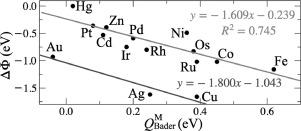当前位置:
X-MOL 学术
›
Surf. Sci.
›
论文详情
Our official English website, www.x-mol.net, welcomes your
feedback! (Note: you will need to create a separate account there.)
Unveiling the Adsorption Properties of 3d, 4d, and 5d Metal Adatoms on the MoS2 Monolayer: A DFT-D3 Investigation
Surface Science ( IF 2.1 ) Pub Date : 2020-11-01 , DOI: 10.1016/j.susc.2020.121700 Rafael Costa-Amaral , Ahmad Forhat , Naidel A. M. S. Caturello , Juarez L. F. Da Silva
Surface Science ( IF 2.1 ) Pub Date : 2020-11-01 , DOI: 10.1016/j.susc.2020.121700 Rafael Costa-Amaral , Ahmad Forhat , Naidel A. M. S. Caturello , Juarez L. F. Da Silva

|
Abstract The adsorption of metal (M) adatoms on two-dimensional (2D) transition-metal dichalcogenides (TMDs) monolayers have been used to tune the physical-chemical properties of 2D TMDs such as MoS2, however, our atomistic understanding of the binding mechanism, site preference, charge transfer, diffusion barriers, etc., of metal adatoms on MoS2 is far from satisfactory. Thus, we report spin-polarized density functional theory calculations within the D3 van der Waals (vdW) correction to characterize the adsorption properties of 15 metal adatoms (3d, 4d, 5d) on MoS2 at low-coverage limit. All adatoms can be separated into two groups, namely, Fe, Co, Ni, Ru, Rh, Os, Ir, and Pt bind covalently to the MoS2 monolayer on the topMo site, where the binding mechanism can be explained by the combination of two factors, namely, (i) distortions within the MoS2 monolayers, which breaks the degeneracy of the electronic states and reduces their magnitude near the valence band maximum, and (ii) strong hybridization between the partially unoccupied d- and Mo d z 2 -states. In contrast, Pd has a strong preference for the hollow site compared with the topMo site, however, Cu, Zn, Ag, Cd, and Hg adatoms bind to the topMo and hollow sites with nearly the same energy (differences less than 0.10eV) due to the weak hybridization of the fully occupied metal d-states, while Au binds preferentially on the topS site. Thus, the M-MoS2 interactions are dominated by covalent and van der Waals interactions, which shows strong and weak dependence on the adsorption site preference, respectively.
中文翻译:

揭示 3d、4d 和 5d 金属吸附在 MoS2 单层上的吸附特性:DFT-D3 研究
摘要 金属 (M) 吸附原子在二维 (2D) 过渡金属二硫属化物 (TMD) 单层上的吸附已被用于调整二维 TMDs 如 MoS2 的物理化学性质,然而,我们对结合机制的原子理解MoS2 上金属吸附原子的位点偏好、电荷转移、扩散势垒等远不能令人满意。因此,我们报告了 D3 范德华 (vdW) 校正内的自旋极化密度泛函理论计算,以表征 15 个金属吸附原子(3d、4d、5d)在低覆盖极限下在 MoS2 上的吸附特性。所有的吸附原子都可以分为两组,即 Fe、Co、Ni、Ru、Rh、Os、Ir 和 Pt 共价结合到 topMo 位点上的 MoS2 单层上,其中结合机制可以通过两者的组合来解释因素,即 (i) MoS2 单层内的畸变,这打破了电子态的简并性并降低了它们在价带最大值附近的幅度,以及 (ii) 部分未占据的 d 态和 Mo dz 2 态之间的强杂化。相比之下,与 topMo 位点相比,Pd 对空心位点有强烈的偏好,但是,Cu、Zn、Ag、Cd 和 Hg 吸附原子以几乎相同的能量(差异小于 0.10eV)与 topMo 和空心位点结合由于完全占据的金属 d 态的弱杂交,而 Au 优先结合在 topS 位点上。因此,M-MoS2 相互作用以共价相互作用和范德华相互作用为主,分别显示出对吸附位点偏好的强依赖性和弱依赖性。这打破了电子态的简并性并降低了它们在价带最大值附近的幅度,以及 (ii) 部分未占据的 d- 和 Mo dz 2 - 态之间的强杂化。相比之下,与 topMo 位点相比,Pd 对空心位点有强烈的偏好,但是,Cu、Zn、Ag、Cd 和 Hg 吸附原子以几乎相同的能量(差异小于 0.10eV)与 topMo 和空心位点结合由于完全占据的金属 d 态的弱杂交,而 Au 优先结合在 topS 位点上。因此,M-MoS2 相互作用以共价相互作用和范德华相互作用为主,分别显示出对吸附位点偏好的强依赖性和弱依赖性。这打破了电子态的简并性并降低了它们在价带最大值附近的幅度,以及 (ii) 部分未占据的 d- 和 Mo dz 2 - 态之间的强杂化。相比之下,与 topMo 位点相比,Pd 对空心位点有强烈的偏好,但是,Cu、Zn、Ag、Cd 和 Hg 吸附原子以几乎相同的能量(差异小于 0.10eV)与 topMo 和空心位点结合由于完全占据的金属 d 态的弱杂交,而 Au 优先结合在 topS 位点上。因此,M-MoS2 相互作用以共价相互作用和范德华相互作用为主,分别显示出对吸附位点偏好的强依赖性和弱依赖性。与 topMo 位点相比,Pd 对空心位点有强烈的偏好,但是,Cu、Zn、Ag、Cd 和 Hg 吸附原子以几乎相同的能量(差异小于 0.10eV)与 topMo 和空心位点结合完全占据的金属 d 态的弱杂交,而 Au 优先结合在 topS 位点上。因此,M-MoS2 相互作用以共价相互作用和范德华相互作用为主,分别显示出对吸附位点偏好的强依赖性和弱依赖性。与 topMo 位点相比,Pd 对空心位点有很强的偏好,但是,Cu、Zn、Ag、Cd 和 Hg 吸附原子以几乎相同的能量(差异小于 0.10eV)与 topMo 和空心位点结合,这是由于完全占据的金属 d 态的弱杂交,而 Au 优先结合在 topS 位点上。因此,M-MoS2 相互作用以共价相互作用和范德华相互作用为主,分别显示出对吸附位点偏好的强依赖性和弱依赖性。
更新日期:2020-11-01
中文翻译:

揭示 3d、4d 和 5d 金属吸附在 MoS2 单层上的吸附特性:DFT-D3 研究
摘要 金属 (M) 吸附原子在二维 (2D) 过渡金属二硫属化物 (TMD) 单层上的吸附已被用于调整二维 TMDs 如 MoS2 的物理化学性质,然而,我们对结合机制的原子理解MoS2 上金属吸附原子的位点偏好、电荷转移、扩散势垒等远不能令人满意。因此,我们报告了 D3 范德华 (vdW) 校正内的自旋极化密度泛函理论计算,以表征 15 个金属吸附原子(3d、4d、5d)在低覆盖极限下在 MoS2 上的吸附特性。所有的吸附原子都可以分为两组,即 Fe、Co、Ni、Ru、Rh、Os、Ir 和 Pt 共价结合到 topMo 位点上的 MoS2 单层上,其中结合机制可以通过两者的组合来解释因素,即 (i) MoS2 单层内的畸变,这打破了电子态的简并性并降低了它们在价带最大值附近的幅度,以及 (ii) 部分未占据的 d 态和 Mo dz 2 态之间的强杂化。相比之下,与 topMo 位点相比,Pd 对空心位点有强烈的偏好,但是,Cu、Zn、Ag、Cd 和 Hg 吸附原子以几乎相同的能量(差异小于 0.10eV)与 topMo 和空心位点结合由于完全占据的金属 d 态的弱杂交,而 Au 优先结合在 topS 位点上。因此,M-MoS2 相互作用以共价相互作用和范德华相互作用为主,分别显示出对吸附位点偏好的强依赖性和弱依赖性。这打破了电子态的简并性并降低了它们在价带最大值附近的幅度,以及 (ii) 部分未占据的 d- 和 Mo dz 2 - 态之间的强杂化。相比之下,与 topMo 位点相比,Pd 对空心位点有强烈的偏好,但是,Cu、Zn、Ag、Cd 和 Hg 吸附原子以几乎相同的能量(差异小于 0.10eV)与 topMo 和空心位点结合由于完全占据的金属 d 态的弱杂交,而 Au 优先结合在 topS 位点上。因此,M-MoS2 相互作用以共价相互作用和范德华相互作用为主,分别显示出对吸附位点偏好的强依赖性和弱依赖性。这打破了电子态的简并性并降低了它们在价带最大值附近的幅度,以及 (ii) 部分未占据的 d- 和 Mo dz 2 - 态之间的强杂化。相比之下,与 topMo 位点相比,Pd 对空心位点有强烈的偏好,但是,Cu、Zn、Ag、Cd 和 Hg 吸附原子以几乎相同的能量(差异小于 0.10eV)与 topMo 和空心位点结合由于完全占据的金属 d 态的弱杂交,而 Au 优先结合在 topS 位点上。因此,M-MoS2 相互作用以共价相互作用和范德华相互作用为主,分别显示出对吸附位点偏好的强依赖性和弱依赖性。与 topMo 位点相比,Pd 对空心位点有强烈的偏好,但是,Cu、Zn、Ag、Cd 和 Hg 吸附原子以几乎相同的能量(差异小于 0.10eV)与 topMo 和空心位点结合完全占据的金属 d 态的弱杂交,而 Au 优先结合在 topS 位点上。因此,M-MoS2 相互作用以共价相互作用和范德华相互作用为主,分别显示出对吸附位点偏好的强依赖性和弱依赖性。与 topMo 位点相比,Pd 对空心位点有很强的偏好,但是,Cu、Zn、Ag、Cd 和 Hg 吸附原子以几乎相同的能量(差异小于 0.10eV)与 topMo 和空心位点结合,这是由于完全占据的金属 d 态的弱杂交,而 Au 优先结合在 topS 位点上。因此,M-MoS2 相互作用以共价相互作用和范德华相互作用为主,分别显示出对吸附位点偏好的强依赖性和弱依赖性。











































 京公网安备 11010802027423号
京公网安备 11010802027423号